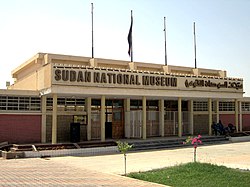National Museum of Sudan

Main entrance of the National Museum of Sudan
|
|
| Established | 1971 |
|---|---|
| Location | El Neel Avenue, Khartoum, |
| Coordinates | 15°36′22″N 32°30′29″E / 15.606°N 32.508°E |
| Type | Archaeological collection of different epochs of Ancient Sudan and Ancient Egypt |
| Website | Sudan National Museum |
The National Museum of Sudan or Sudan National Museum, abbreviated SNM, is a double storied building constructed in 1955 and established as a museum in 1971. The building and its surrounding gardens house the largest and most comprehensive Nubian archaeological collection in the world including objects from the Paleolithic through to the Islamic period originating from every site of importance in the Sudan.
In particular it houses collections of these periods of the History of Sudan: Paleolithic, Mesolithic, Neolithic, A-Group culture, C-Group culture, Kerma Culture, Middle Kingdom of Egypt, New Kingdom of Egypt, Napata, Meroë, X-Group culture and medieval Makuria.
The museum is located on the El Neel (Nile) Avenue in Khartoum in Al-Mugran area near the spot where the White and the Blue Niles meet.
The objects of the museum are displayed in four areas:
The objects of the ground floor are displayed chronologically and laid out clockwise: Key highlights of the collections include:
Kerma Culture jug with a beak in the shape of a hippopotamus head
Stela of the chief of Teh-khet, Amenemhat
Female Demon Beset
Bronze with gold statue of a Meroitic king as an archer
Beginning of CE sandstone-carved Meroitic statue raising its left arm
Fresco of Faras cathedral
The story from Daniel and of the three youths thrown into the furnace.
In the museum garden are rebuilt some temples and tombs relocated from the submergence area of Lake Nasser. The Aswan High Dam built across the Nile River in Egypt created a reservoir in the Nubia area, which extended into Sudan's territory threatening to submerge the ancient temples. During the UNESCO Salvage Campaign the following temples and tombs were re-erected in the museum garden according to the same orientation of their original location surrounding an artificial strip of water symbolic of the Nile:
...
Wikipedia

